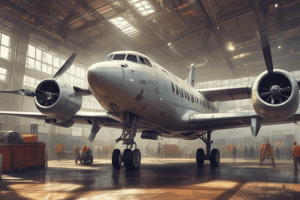Podcast
Questions and Answers
What are the historical milestones in aeronautical engineering?
What are the historical milestones in aeronautical engineering?
Various significant events and developments in aircraft design and technology.
What does an 'order of magnitude' refer to in this course?
What does an 'order of magnitude' refer to in this course?
The scale or size of something expressed in powers of ten.
List some airplane operational features.
List some airplane operational features.
Payload, max takeoff mass, range, cruise altitude, cruise speed, landing speed.
What is the primary importance of payload in airplane design?
What is the primary importance of payload in airplane design?
Which weight is NOT one of the weight categories for aircraft?
Which weight is NOT one of the weight categories for aircraft?
Define flight range in the context of aviation.
Define flight range in the context of aviation.
Flashcards are hidden until you start studying
Study Notes
Course Goal and Objectives
- The course focuses on understanding aircraft within the civil air transport system
- Students can expect to learn about the historical development of aeronautical engineering
- They will also explore the operational features of airplanes within different categories and understand how these features relate to specific missions
- The course will cover the identification of different airplanes and their manufacturers, including descriptions of their geometric and operational features
- It will delve into the details of various airplane categories and their unique features
- Students will gain the ability to determine the size of an airplane based on its operational features and to visually represent it using those features
Orders of Magnitude
- Orders of magnitude represent the scale or size of something with powers of ten
- In this context, orders of magnitude refer to the scale or size of airplanes
Airplane Operational Features
- Payload refers to the weight an aircraft can transport, a key factor for airline revenue
- Max Take Off Weight (MTOW) is the maximum weight an aircraft can have at liftoff
- Max Landing Weight (MLW) is the maximum weight an aircraft can have when landing
- Max Zero Fuel Weight (MZFW) is the maximum weight an aircraft can have without fuel
- Range represents the maximum distance an aircraft can fly without refueling
- Cruise Altitude is the optimal altitude for efficient flight
- Cruise Speed is the aircraft's speed during cruise flight
- Flight Duration refers to the total time an aircraft can fly
- Takeoff and Landing Distances are the minimum distances required for takeoff and landing safely
- Landing Speed is the speed at which an aircraft touches down
- Thrust and Power are critical for aircraft safety and performance
Airplane Weight
- MTOW: Max Take Off Weight
- MLW: Max Landing Weight
- MZFW: Max Zero Fuel Weight
- TOW: Takeoff Weight
- LW: Landing Weight
- ZFW: Zero Fuel Weight
- OEW: Operating Empty Weight
- MEW: Manufacturer's Empty Weight
- Payload includes passengers, baggage, and cargo
- Operator’s items comprise items for commercial service (seats, catering, crews, water)
- Aircraft weight out of assembly line includes the structure, powerplant, systems, and furnishings
Flight Range
- Flight range refers to the distance an aircraft can fly between takeoff and landing
- Ground distance or surface distance represents the actual distance traveled on the ground
- Flight distance or air distance represents the total distance traveled in the air, accounting for deviations due to air currents and wind conditions
Studying That Suits You
Use AI to generate personalized quizzes and flashcards to suit your learning preferences.




